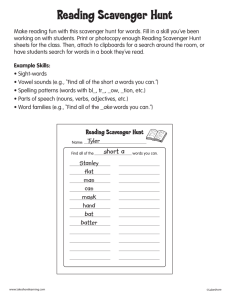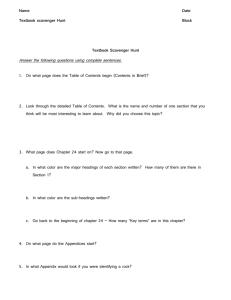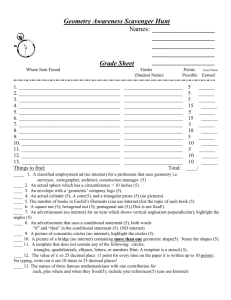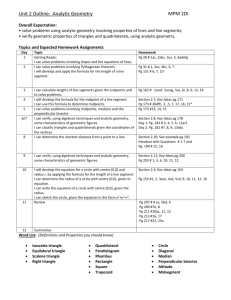File - ePortfolio
advertisement
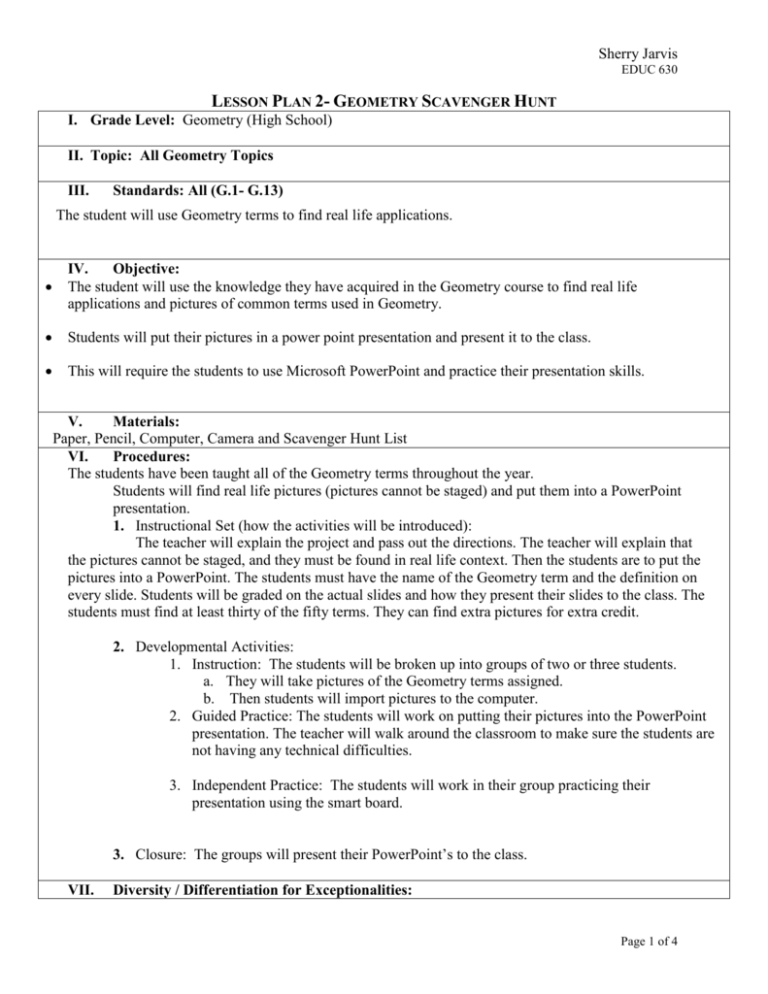
Sherry Jarvis EDUC 630 LESSON PLAN 2- GEOMETRY SCAVENGER HUNT I. Grade Level: Geometry (High School) II. Topic: All Geometry Topics III. Standards: All (G.1- G.13) The student will use Geometry terms to find real life applications. IV. Objective: The student will use the knowledge they have acquired in the Geometry course to find real life applications and pictures of common terms used in Geometry. Students will put their pictures in a power point presentation and present it to the class. This will require the students to use Microsoft PowerPoint and practice their presentation skills. V. Materials: Paper, Pencil, Computer, Camera and Scavenger Hunt List VI. Procedures: The students have been taught all of the Geometry terms throughout the year. Students will find real life pictures (pictures cannot be staged) and put them into a PowerPoint presentation. 1. Instructional Set (how the activities will be introduced): The teacher will explain the project and pass out the directions. The teacher will explain that the pictures cannot be staged, and they must be found in real life context. Then the students are to put the pictures into a PowerPoint. The students must have the name of the Geometry term and the definition on every slide. Students will be graded on the actual slides and how they present their slides to the class. The students must find at least thirty of the fifty terms. They can find extra pictures for extra credit. 2. Developmental Activities: 1. Instruction: The students will be broken up into groups of two or three students. a. They will take pictures of the Geometry terms assigned. b. Then students will import pictures to the computer. 2. Guided Practice: The students will work on putting their pictures into the PowerPoint presentation. The teacher will walk around the classroom to make sure the students are not having any technical difficulties. 3. Independent Practice: The students will work in their group practicing their presentation using the smart board. 3. Closure: The groups will present their PowerPoint’s to the class. VII. Diversity / Differentiation for Exceptionalities: Page 1 of 4 Sherry Jarvis EDUC 630 A. Learning Styles (modalities / multiple intelligences) – Students will be in groups of two to three depending on class size. Students who do not feel comfortable working with others can work alone. The groups can break up the project how they see fit, as long as everyone has an equal part. Some students may feel more comfortable finding the definitions or working with the computer. B. Gifted – These students will be paired with the weaker students C. LEP - These students could have a person in their group who is a translator or friend to help them out. D. LD, ED, ADD – These students will be placed in a group with the gifted students E. Multicultural Connections – The student’s are free to find any pictures they want. So some students will find pictures that display their heritage. VIII. Evaluation: The students will be evaluated as a group on their presentations, as well as their slide content and design. IX. Risk Analysis: Computer glitches and Internet connectivity issues are probably the main issues that would be addressed in this lesson. Usually when computer issues arise, the teacher will try to disconnect and reconnect the computer to the Internet. If this does not resolve the issue, the students will get another computer. The students may have questions along the way dealing with their photos. They can have the teacher look at their pictures to see if they match the Geometry term to maximize their points. *** Attached is the list of terms for the Geometry Scavenger Hunt. Page 2 of 4 Sherry Jarvis EDUC 630 Geometry Scavenger Hunt Terms to define and find in the scavenger hunt. Objects can be found in/around home, school or the community. Pictures cannot be staged. Students will be expected to import the pictures into a power point presentation. The presentations will be presented in front of the class. 1.Acute Triangle 2.Acute Angle 3. Adjacent Angles 4. Alternate Interior Angles 5. Center of a Circle 6. Chord of a Circle 7. Circle 8. Circumscribed Circle 9. Compass 10. Complementary Angles 11. Concave Polygon 12. Concentric Circles 13. Cone 14. Convex Polygon 15. Corresponding Angles 16. Cube 17. Cylinder 18. Equilateral Triangle 19. Hexagon 20. Horizontal Line Segment 21. Inscribed Circle 22. Isosceles Triangle 23. Kite 24. Major Arc 25. Minor Arc 26. Oblique Figure 27. Obtuse Angle 28. Obtuse Triangle 29. Octagon 30. Parallel Lines 31. Pentagon 32. Perpendicular Lines 33. Prism 34. Protractor 35. Pyramid 36. Rectangle 37. Rectangular Solid 38. Rhombus 39. Right Angle 40. Right Triangle 41. Scalene Triangle 42. Semicircle 43. Sphere 44. Square 45. Supplementary Angles 46. Symmetry 47. Tangent to a Circle 48. Trapezoid 49. Vertical Angles 50. Vertical Line Segment *Term Scores A B C D F 40 Terms 30 - 39 Terms 20 - 29 Terms 10 -19 Terms Below 10 Terms ** Students may find extra terms for 1 point extra credit each. Page 3 of 4 Sherry Jarvis EDUC 630 PowerPoint Design The presentation should start with a title slide with “Geometry Scavenger Hunt” and the name of the presenter(s). Each slide should have a different term on the slide with the name of the term, the definition and picture. Presentation Requirements The presenter(s) should read the slide to the class. Then the presenter must outline where in the picture the term is, using the stylus pen on the smart board. Page 4 of 4
